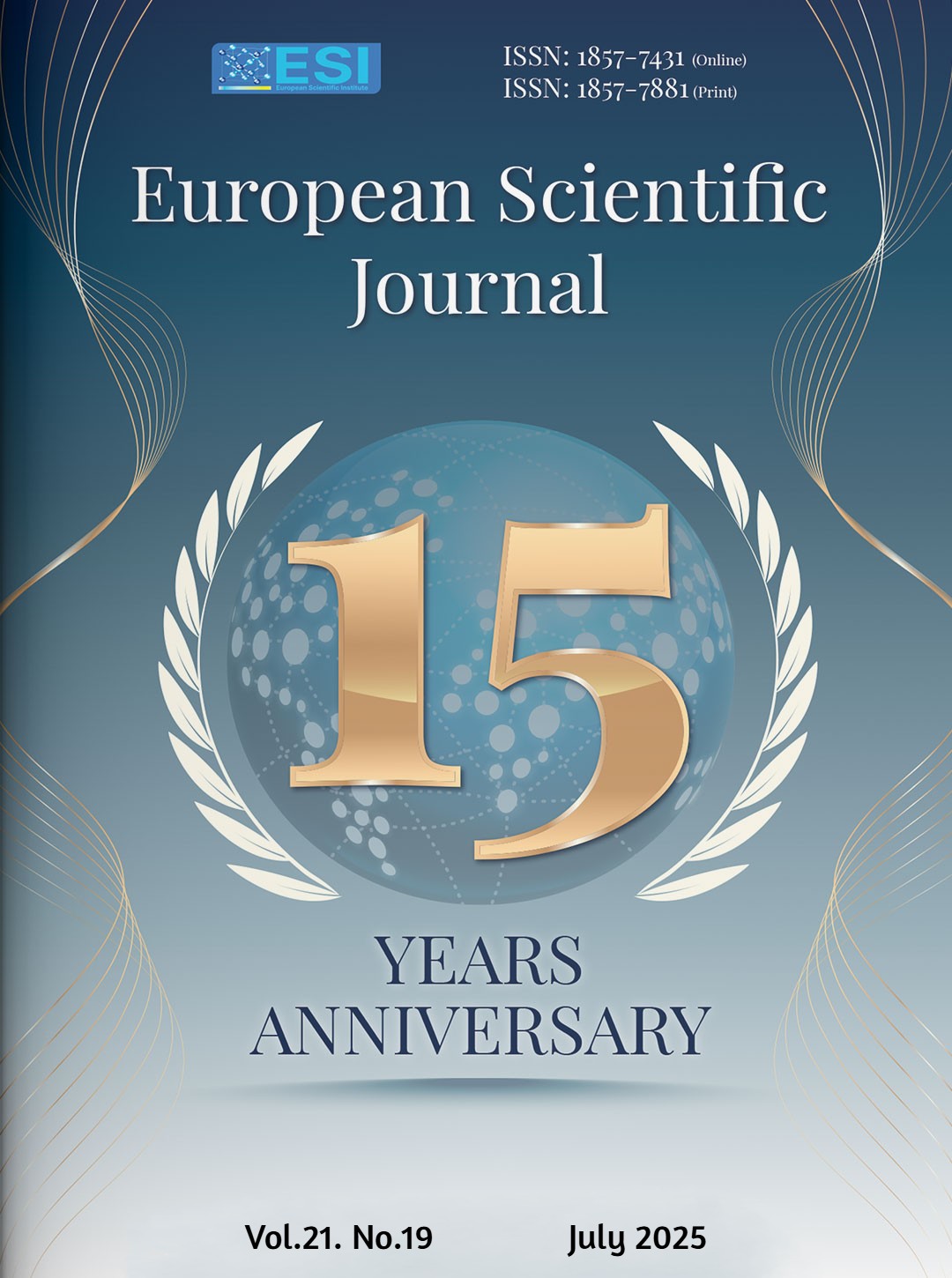Conceptual Formation of Curvature in the Logic of Art: An Educational Mathematical Approach
Abstract
This article investigates how curvature, commonly examined in differential geometry, functions as a conceptual and visual bridge between mathematics and the arts. Focusing on its presence in both abstract artworks (e.g., Kandinsky, Pollock) and architectural design (e.g., Gaudí), the study analyzes how mathematical curves such as parabolas, sinusoids, and exponential spirals are embedded in artistic compositions. Rather than treating curvature as a purely technical metric, the study presents it as a perceptual and compositional tool that structures form, evokes emotion, and communicates symbolic meaning. The paper introduces readers to core geometric principles underpinning curvature and their visual and compositional applications in art, aiming to make these concepts accessible to non-specialist readers. Employing case studies of historical and contemporary artworks, it highlights how mathematical patterns manifest intuitively in artistic practice. Key implications include the potential for curvature to foster interdisciplinary education, particularly through STEAM learning models that integrate science, technology, engineering, the arts, and mathematics. This approach encourages enriched classroom engagement, deeper visual literacy, and a broader appreciation of form as both analytic structure and expressive language.
Downloads
Metrics
PlumX Statistics
References
2. Andrés F. A-A. & Franco, C. A. (2021). The Creative Act in the Dialogue between Art and Mathematics, Mathematics, MDPI, 9(13), 1517, 1-26. https://doi.org/10.3390/math9131517
3. Arnheim, R. (1974). Art and Visual Perception: A Psychology of the Creative Eye. University of California Press.
4. Boaler, J. (2016). Mathematical mindsets: Unleashing students' potential through creative math, inspiring messages, and innovative teaching. Jossey-Bass/Wiley.
5. Cast (2018). UDL Guidelines 3.0. http://udlguidelines.cast.org
6. Devlin, K. (2011). Mathematics education for a new era: Video games as a medium for learning. 1st Edition, A K Peters/CRC Press. https://doi.org/10.1201/b10816
7. Fierro-Newton, P. (2024). The Emotional Impact of Curved vs. Angular Designs. https://neurotectura.com/2024/12/31/the-emotional-impact-of-curved-vs-angular-designs/?utm_source=chatgpt.com
8. Friedman, M. & Carter, M. (1991). Curvature in Art and Nature. Journal of Aesthetic Education, 25(3), 85-96.
9. Gao, J. and Newberry, M. (2024). Fractal Scaling and the Aesthetics of Trees, Physics and Society, arXiv:2402.13520 [physics.soc-ph]. https://doi.org/10.48550/arXiv.2402.13520
10. Gombrich, E. H. (1960). Art and Illusion: A Study in the Psychology of Pictorial Representation. Princeton University Press.
11. Grieve, A. (2018). The Scientific Narrative of Leonardo’s Last Supper, Jour. of Excellence in Integrated Writing at Wright State University, Vol. 5(1).
12. Henderson, D. W. & Taimina, D. (2001). Crocheting the hyperbolic plane. The Mathematical Intelligencer 23, 17–28. https://doi.org/10.1007/BF03026623
13. Henriksen, D., Mishra, P. & Fisser, P. (2016). Infusing creativity and technology in 21st-century education: A systemic view for change. Educational Technology & Society, 19(3), 27–37. https://www.researchgate.net/publication/311670214
14. Hoffman, D. D. & Richards, W. (1984). Parts of recognition. Cognition, 18(1-3), 65-96. https://doi.org/10.1016/0010-0277(84)90022-2
15. Kandinsky, W. (1947). Concerning the Spiritual in Art. Wittenborn, Schultz, Inc.
16. Kempkes, S. N., Slot, M. R., Freeney, S. E., Zevenhuizen, S. J. M., Vanmaekelbergh, D., Swart, I., & Morais Smith, C. (2019). Design and characterization of electrons in a fractal geometry. Nat. Phys. 15, 127–131. https://doi.org/10.1038/s41567-018-0328-0
17. Kreyszig, E. (1991). Differential Geometry. Dover Publications.
18. Kühnel, W. (2006). Differential Geometry: Curves, Surfaces, Manifolds. American Mathematical Society. ISBN 0-8218-3988-8.
19. Lisi & Nagappan, R. (2024). Exploring the Interconnections and Practical Applications of Art within a STEAM Education Curriculum. International Journal of Education and Humanities. 16(2), 193-197. https://doi:10.54097/xs0n7598
20. Livio, M. (2002). The Golden Ratio: The Story of Phi, the World's Most Astonishing Number. Broadway Books.
21. McRobie, A. (2017). The Seduction of Curves: The Lines of Beauty that Connect Mathematics, Art and the Nude. Princeton University Press. ISBN: 9780691175331.
22. Middleton, J. & Petruzzello, M. (2024). "Sagrada Família". Encyclopedia Britannica, 3 Oct. 2024, https://www.britannica.com/topic/Sagrada-Familia
23. Pressley, A. (2001). Elementary Differential Geometry. Springer.
24. Rose, D. H., & Meyer, A. (2002). Teaching every student in the digital age: Universal design for learning. Association for Supervision and Curriculum Development (ASCD). ISBN: ISBN-0-87120-599-8.
25. Ruta, N., Vano, J., Peppereli, R., Corradi, G. B., Chuquichambi, E. G., Rey, C. & Munar, E. (2023). Preference for paintings is also affected by curvature. Psychology of Aesthetics, Creativity, and the Arts, 17(3), 307-321. https://doi.org/10.1037/aca0000395
26. Schoevers, E. M., Leseman, P. P. M. & Kroesbergen, E. H. (2019). Enriching Mathematics Education with Visual Arts: Effects on Elementary School Students’ Ability in Geometry and Visual Arts. International Journal of Science and Mathematics Education, 18, 1613–1634. https://doi.org/10.1007/s10763-019-10018-z
27. Silva, P. J. & Barona, C. M. (2009). Do People Prefer Curved Objects? Angularity, Expertise, and Aesthetic Preference, Empirical Studies of Arts, 27(1), 25-42. https://doi:10.2190/EM.27.1.b
28. Sinclair, N., & Watson, A. (2001). The aesthetic is relevant. For the Learning of Mathematics, 21(1), 25–32. https://eric.ed.gov/?id=EJ627148
29. Smith, D. E. (1958). History of Mathematics, Vol. 2. New York, NY: Dover Publications.
30. Sousa, D. A. (2016). How the brain learns (5th ed.). Corwin Press. https://www.amazon.com/How-Brain-Learns-David-Sousa/dp/1506346308
31. Sylviani, S., Permana, F. C. & Azizan, A. T. (2024). Enhancing Mathematical Interest through Visual Arts Integration: A Systematic Literature Review, International Journal of Education in Mathematics, Science and Technology, 12(5), 1217-1235. https://doi.org/10.46328/ijemst.4118
32. Taylor, R. P., Spehar, B., Clifford, C. W. G., & Newell, B. R. (2008). The Visual Complexity of Pollock’s Dripped Fractals. In: Minai, A.A., Bar-Yam, Y. (eds.) Unifying Themes in Complex Systems IV, 175–182. Springer, Heidelberg.
33. Taylor, R. P., Spehar, B., Van Donkelaar, P., & Hagerhall, C. M. (2011). Perceptual and physiological responses to Jackson Pollock’s fractals. Frontiers in Human Neuroscience, Vol. 5, Article 60, 1-13. doi:10.3389/fnhum.2011.00060
34. UNESCO. (2015). Cracking the code: Girls' and women's education in science, technology, engineering and mathematics (STEM). United Nations Educational, Scientific and Cultural Organization. https://unesdoc.unesco.org/ark:/48223/pf0000253479
Copyright (c) 2025 Vassileios Petrakis, Lambrini Seremeti, Ioannis Kougias

This work is licensed under a Creative Commons Attribution 4.0 International License.








